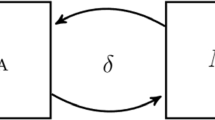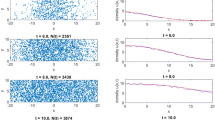Abstract
Amongst the most frequently made assumptions in simple population models are that individuals interact equally with every other individual and that dispersal occurs with equal likelihood to any location. This is especially true for models of a single population (as opposed to a patchy population or metapopulation). For many species of animals and probably for all plant species these assumptions are unlikely to hold true. Here one much-studied population model—the Ricker model—is reformulated such that interactions occur only between individuals located within a certain distance of each other and dispersal distance is finite. Two alternative reformulations are presented. Results demonstrate that both limiting the interaction neighbourhood and reducing dispersal distance tend to stabilise the global population dynamics, although the extent to which this occurs depends upon the reformulation used. Spatial pattern formation is a feature of the simulated population. At lower intrinsic rates of growth (r) these patterns tend to be static, while for higher r, they are dynamic. Both the stabilisation of global dynamics and spatial pattern formation are well-described features of metapopulation models. Here, similar effects are shown to occur on a single contiguous patch of habitat.









Similar content being viewed by others
References
Berec L (2002) Techniques of spatially explicit individual-based models: construction, simulation and mean-field analysis. Ecol Model 150:55–81
Biging GS, Dobbertin W (1992) A comparison of distance-dependent competition measures for height and basal growth of individual conifer trees. For Sci 38:695–720
Bolker BM, Pacala SW (1997) Using moment equations to understand stochastically driven spatial pattern formation in ecological systems. Theor Popul Biol 52179–197
Bolker BM, Pacala SW (1999) Spatial moment equations for plant competition: understanding spatial strategies and the advantages of short dispersal. Am Nat 157:217–230
Bolker BM, Pacala SW, Levin SA (2000) Moment methods for ecological processes in continuous space. In: Dieckmann U, Law R, Metz JAJ (eds) The Geometry of ecological interactions. Cambridge University Press, Cambridge, pp 388–411
Costantino RF, Desharnais RA, Cushing JM, Dennis B (1997) Chaotic dynamics in an insect population. Science 275:389–341
Czaran T (1998) Spatiotemporal models of population and community dynamics. Chapman and Hall, London
Dennis B, Desharnais RA, Cushing JM, Costantino RF (1995) Nonlinear demographic dynamics: mathematical models, statistical methods and biological experiments. Ecol Monogr 65:261–268
Ellner S, Turchin P (1995) Chaos in a noisy world: new methods and evidence from time series analysis. Am Nat 145:343–375
Godfray HCJ, Grenfell BT (1993) The continuing quest for chaos. Trends Ecol Evol 8:43–44
Hanski I (1999) Metapopulation ecology. Oxford University Press, Oxford
Hassell MP, Lawton JH, May RM (1976) Patterns of dynamical behaviour in single species populations. J Anim Ecol 42:471–486
Hassell MP, Comins HN, May RM (1991) Spatial structure and chaos in insect population dynamics. Nature 353:255–258
Hassell MP, Comins HN, May RM (1994) Species co-existence and self-organizing spatial dynamics. Nature 370:290–294
Hastings A, Hom CL, Ellner S, Turchin P, Godfray HCJ (1993) Chaos in ecology: Is mother nature a strange attractor? Annu Rev Ecol Syst 24:1–33
Jaggi S, Joshi A (2001) Incorporating spatial variation in density enhances the stability of simple population dynamics models. J Theor Biol 209:249–255
Law R, Dieckmann U (2000) A dynamical system for neighbourhoods in plant communities. Ecology 81:2137–2148
Law R, Murrell DJ, Dieckmann U (2002) On population growth in space and time: the spatial logistic equation. Ecology 84:252–262
Matsuda HN, Ogita A, Sasaki A, Sato K (1992) Statistical mechanics of population: the lattice Lotka-Volterra model. Prog Theor Phys 88:1035–1049
May RM (1974) Biological populations with nonoverlapping generations: stable points, stable cycles and chaos. Science 186:645–647
Neubert MG, Kot M, Lewis MA (1995) Dispersal and pattern-formation in a discrete-time predator-prey model. Theor Popul Biol 48:7–43
Pacala SW (1986) Neighborhood models of plant population dynamics. 2. Multi-species models of annuals. Theor Popul Biol 29:262–292
Pacala SW (1987) Neighborhood models of plant population dynamics. III. Models with spatial heterogeneity in the physical environment. Theor Popul Biol 31:359–392
Pacala SW, Silander JA Jr (1985) Neighborhood models of plant population dynamics. I. Single-species models of annuals. Am Nat 125:385–411
Ricker WE (1958) Handbook of computations for biological statistics of fish populations. Fisheries Research Board of Canada, Vancouver
Rohde K, Rohde PP (2001) Fuzzy chaos: reduced chaos in the combined dynamics of several independently chaotic populations. Am Nat 158:553–556
Soares P, Tome M (1999) Distance-dependent competition measures for eucalyptus plantations in Portugal. Ann For Sci 56:307–319
Stenseth NC, Bjǿrnstad ON, Saitoh T (1996) A gradient from stable to cyclic populations of Clethrionomys rufocanus in Hokkaido, Japan. Proc R Soc London B 263:1117–1126
Thomas WR, Pomerantz MJ, Gilpin ME (1980). Chaos, asymmetric growth and group selection for dynamical stability. Ecology 61:1312–1320
Travis JMJ, Dytham C (1999) Habitat persistence, habitat availability and the evolution of dispersal. Proc R Soc London B 266:1837–1842
Turchin P, Taylor AD (1992) Complex dynamics in ecological time series. Ecology 73:289–305
Wang MH, Kot M, Neubert MG (2002) Integrodifference equations, Allee effects, and invasions. J Math Biol 44:150–168
Wilson WG, Harrison SP, Hastings A, McCann K (1999) Exploring stable pattern formation in models of tussock moth populations. J Anim Ecol 68:94–107
Acknowledgements
Calvin Dytham, David Murrell and Will Wilson are thanked for commenting on a previous version of the manuscript. I am very grateful to Nils Koesters and Rachel Atkinson for useful discussion and criticism. Two anonymous referees provided some very constructive criticism that helped to greatly improve the manuscript.
Author information
Authors and Affiliations
Corresponding author
Rights and permissions
About this article
Cite this article
Travis, J.M.J. Neighbourhood size, dispersal distance and the complex dynamics of the spatial Ricker model. Popul Ecol 45, 227–237 (2003). https://doi.org/10.1007/s10144-003-0161-9
Received:
Accepted:
Published:
Issue Date:
DOI: https://doi.org/10.1007/s10144-003-0161-9




